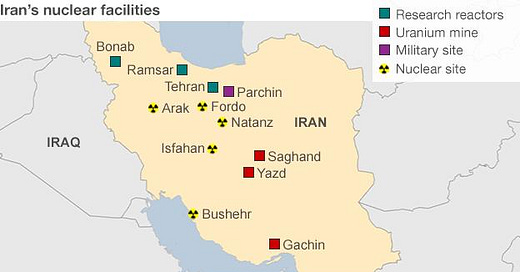Sixty days have passed since Donald Trump’s ultimatum to Iran expired. It looks as if, undeterred by the mediocre results of his costly air campaign against the Houthis, Trump is preparing to put his money where his mouth is. The US is now evacuating non-essential personnel from embassies across the Gulf, has deployed bombers to Diego Garcia and Qatar, and the Pentagon’s pizza index is rising, preparing for possible military action. With tensions peaking, Washington and Jerusalem face a momentous choice: whether to strike Iran’s nuclear facilities. What would such a strike achieve and what might it unleash?
This article examines four scenarios: (1) the US acts alone, (2) a joint US-Israel operation, (3) an Israeli-only strike, and (4) do nothing. I assess military feasibility, escalation risks, and global ramifications, including the potential responses across the Middle East, as well as the overall global implications.
Scenario 1: Unilateral US Strike
A solo American strike would unleash unparalleled military power. US bombers and cruise missiles could target Iran’s fortified sites with pinpoint accuracy. The US alone possesses the 30,000-pound GBU-57 “Massive Ordnance Penetrator,” capable of obliterating deeply buried targets.
According to former CENTCOM Commander General Kenneth McKenzie, such a strike could delay Iran’s nuclear timeline by “years.” However, it would be unlikely to eliminate the threat completely. As Mark Fitzpatrick of the IISS notes, “You can’t bomb nuclear knowledge.” Iran could rebuild, possibly in secret, and might respond by accelerating its efforts towards weaponisation as a deterrent.
International reactions would be the usual obligatory wet lettuce finger-wagging. American allies in Europe could criticise the attack as a violation of sovereignty and a setback for diplomacy. Still, with Trump in the White House, any criticism is likely to be well-veiled. Without doubt, China in particular and, possibly, key Iranian ally Russia (although they are pretty busy right now) would capitalise on the strike to bolster Tehran and accuse the US of destabilising the region.
More interesting: Iran’s possible retaliation. After Qassem Soleimani’s killing in 2020, Iran launched ballistic missiles at Al-Asad Air Base in Iraq, injuring over 100 American troops. This time, the stakes are higher. Iranian leadership has vowed that an attack on its nuclear infrastructure would trigger “widespread retaliation.” The most likely response would be ballistic missile attacks on US bases in Bahrain, Qatar, and the UAE; cyberattacks on American infrastructure; and mobilisation of what remains of Iranian proxies across the region, although Israel has severely damaged Iran’s regional capabilities since 7th October.
Cyber retaliation could pose far greater dangers. Iran’s 2012 Shamoon attack wiped out 30,000 computers at Saudi Aramco. Hackers have targeted US financial institutions and critical infrastructure. A 2024 Rand study warns that a strike on Iran could provoke a “broad and persistent Iranian cyber campaign against Western targets.”
Even a decisive US strike might only yield a tactical victory at the expense of strategic escalation. Worse still, it might unify Iranian factions, bolster the IRGC, and eliminate what little incentive Tehran has to remain below the nuclear threshold.




